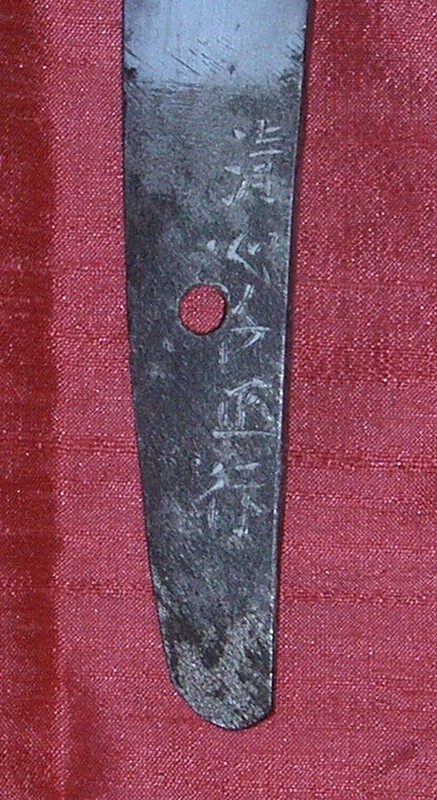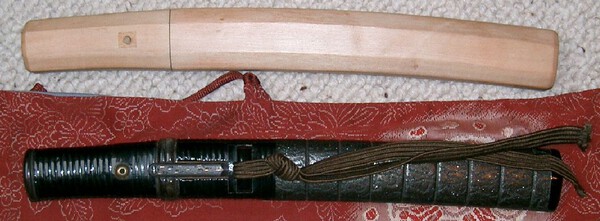
Geraint
Members-
Posts
3,086 -
Joined
-
Last visited
-
Days Won
9
Content Type
Profiles
Forums
Events
Store
Downloads
Gallery
Everything posted by Geraint
-
Hi Mike, Tony is right about the kurikata but if you keep your eyes open you will find quite a few of this type of fitting around. They crop up with some regularity and although I have no evidence to support my feeling it is that they are very late fittngs, produced en mass. They are however Japanese fittings. All the best.
-
Just a thought, are you certain that they are solid cast metal? From time to time menuki do seem to appear with the back filled with different substances, if this is a later koshirae as you suggest and as it seems to be, I would have expected pressed metal menuki if anything...........?
-
How does one determine value?
Geraint replied to obiwanknabbe's topic in General Nihonto Related Discussion
Hi Kurt While nt exactly answering your question you might find the suggestions from this site interesting. http://members.chello.nl/tfujimot/ All the best. -
Ah, Jean. Oil on troubled water?
-
What makes a tsuba more desirable?
Geraint replied to LakeBum's topic in Auctions and Online Sales or Sellers
Hi Jason. You are right, this is a huge topic. If you have not already come across this site, http://www.japaneseswordindex.com then it is a useful starting place. Another good beginning would be to really look at the tsuba illustrated in some of the better books, have a look here for these, http://www.japaneseswordbooksandtsuba.com/about. When I say really look I do mean just that, take your time, come back to the images time and again, understand the way the tsuba was produced and the detail of surface and patination. I suppose a simple answer to your question might be, great artistry, great materials and great execution but I realise that begs the question a bit. Some collectors really see greatness in iron tsuba while some prefer kinko. Whatever you chose to study Ebay is not likely to be the best place to see high quality stuff and a lot of looking will 'get your eye in' Sword shows and society meets are great because you can get a good look at what other collectors are enthusing about and there is nothing like study in hand, especially with someone who can point out to you what they see. I am confident that many members will chime in with their ideas. Whatever you chose to do it will be great fun. All the best. -
Hi Christophe, I have bought from Alan and he has been nothing less than totally reliable. If you are interested e mail him and I am sure he will help you out. Regards.
-
Hi Tom. Not sure where in the UK you are but you made it to Birmingham so hopefully you are within reach of the Northern Token Society, if much to the South then the Token Society of Great Britain meets in London. Chances for you to meet others and see some good stuff plus expose yourself, (perhaps I should reword that?) to some really knowledgable opinions and maybe even some stuff for your collection. If you are in the South West give me a PM.
-
The Chinese are faking showa-to now
Geraint replied to brannow's topic in Auctions and Online Sales or Sellers
One turned up in a local auction in full koshirae and it was very good. The finish on the fittings still slightly off but very close and the blade looked at first glance like a poorly repolished showato. The hada was much finer than usual copies and the whole thing would easily fool a new collector. In hand it was relatively straight forward to spot but using on line images would be tough. few years from now when they have acquired a little age........ -
Hi Donny. What makes you think the blade is Koto? Cheers.
-
Hi David, Just to close the loop from your original question,you are correct to assume that this is an Army parade sabre, usually found with a chrome plated blade with an acid etched hamon on better quality ones. Yours seems to be in nice order. The source you need is probably Ohmura's Gunto site. Cheers
-
Hi Kurt. I am not sure that you should jump to the conclusion that this is a kao but it certainly looks like a kanji. I can't make it out but perhaps if you take a rubbing and try turning it around you might recognise it. It is not unheard of for a smith to use the mune of the nakago to add information but I don't think that will apply to this sword, especially if it is kazu uchimono. Perhaps some sort of assembly mark or something like that. Let us know what you find out. All the best.
-
Hi Junichi. These are beautiful. Looking at the two Kanasugi examples you say that there is etching on the top of Mt Fuji and that the snow cap is shibuichi. Is what I am seeing the result of very fine textured lines on the lower slopes and a small irregular area left free of these before the snow cap? I ask because it looks almost as if three metals have been used but I am guessing that that is the effect of the light that the artist were using. Many thanks.
-
And very nice koshirae from my point of view. Enjoy.
-
Hi Frank. I will try to get some photos of mine for you later but for now; http://www.aoijapan.com/yari-toshiyoshi-not-guarantee Your yari looks to have been three sided, san kaku. The tsuka is obviously for the square nakago and the saya is also designed to accommodate the kerakubi, the shape at the base of the blade. Most of the examples I have seen would be mid to late edo period, they were a way of using a favoured yari according to the scant information I have come across. There is a rather spiffy example here, http://www.juwelier-strebel.de/en/asien ... -yari.html Hope this helps.
-
Confucius say, "Man who set money on fire lose the money. Man who polish own sword lose the money and sword."
-
Dear Brandon. Quickest and probably easiest to borrow a camera and post here as you will; have access to a broad range of expertise. However you might contact these guys; http://www.ricecracker.com/ BAsed in San Pedro, any use to you? Cheers.
-
Gendai tanto by Sunaga? Masayuki
Geraint replied to george trotter's topic in General Nihonto Related Discussion
Good work George, hadn't seen that one before. So far all that I have seen have been small, rather thick and in similar mounts in that all have some interesting lacquer work and either horn or lacquered fittings. I imagine that he was reduced to making them as a result of the Haitorei. Mine has a very prominent hada, the sort that you sometimes see on shinshinto as a result of mixing steels. Be nice to see what yours comes up like with a polish. All the best. -
Gendai tanto by Sunaga? Masayuki
Geraint replied to george trotter's topic in General Nihonto Related Discussion
He is in Hawley's, from memory mas1444. I have a very similar blade by him, it would seem that he made a specialty of tanto. I have never come across katana or wakizashi but this would be the fourth tanto and all very similar sugata. Enjoy. -
Hi Ben. I have never dismounted one of these but you may find one of the following; a screw on one of the menuki fitting into a threaded shank on the other, the same but with a left hand thread just to confuse things, less likely a round shank on one fitting into a hollow shank on the other. I would advise real caution, if they have not been moved for some time they might be quite tight. Looking forward to seeing what you find. All the best.
-
Hi Ben. Wish I had inherited something like that. You should compare to this example which looks very similar. http://www.aoijapan.com/tachikoshirae-s ... -lacquered There was a stunning pair illustrated in the NBTHK journals, male and female pheasant and quite beautiful. These seem to be much later and of much lower quality, none the less a nice thing to have. All the best. Geraint Edit. Thought I had seen another recently, http://www.thelanesarmoury.co.uk/viewph ... 348&phqu=7
-
Is it easy to spot a saiha (retempered blade) ?
Geraint replied to chameloon's topic in General Nihonto Related Discussion
The other issue that Laurent's post raises is the peril of buying an out of polish blade from Ebay. It would be lovely if every out of polish blade turned out to be wonderful once the polisher works on it but that is a risk that we take when we buy the blade, is it not? The risk is great enough when we have the blade in hand, at least we have the opportunity to study it closely whereas any internet purchase does put one at the mercy of digital photographs at the very best. While some flaws may be obvious, even in an out of polish blade, others may only reveal themselves once the polisher removes metal. Of course some of the treasure hunter lives in all of us and the temptation to take a gamble is strong. Usually the best stories about great blades bought unpolished and restored to glory tend to come from experienced collectors. I have a painful story about a seemingly undistinguished armour that had passed through the public marketplace for some time and been dismissed by many including myself. An experienced collector quietly snapped it up because he recognised it for what it was. Fortune it seems, favours those who study. -
I think the images on the link are exaggerated to illustrate clearly. There is perilously little space to shape the tsuka around the nakago so in most cases it is a rather shallow inward curve as you illustrate. Here is another:
-
Try this Jeremy, a little down the page for your answer. http://home.earthlink.net/~steinrl/kosh ... shirae.htm Cheers.
-
If you are thinking of having a new shirasaya then it might be worth attempting the usual trick. Assuming your man used rice glue and not a modern adhesive then it ought to be possible to spring the shirasaya apart, cut back the wood where touching and re glue it. Absolutely no sanding as the abrasive will remain in the timber and cause scratching. This is probably going to fail as I suspect the glue which is causing you a problem is a modern adhesive in which case you are most likely to damage the shirasaya beyond repair, hence the suggestion that you only attempt this if you are already planning a new one. As to opening out the mouth of a saya to accept a wooden habaki, well that sounds barmy to me, much easier to ease the size of the habaki to fit. Have fun.
-
Oh, and one more thing; watch out for the positioning of the spring latch, this must line up from it's position in the tsuka, through all seppa and tsuba and also into the koiguchi of the saya. They are much more of an individual fit than you might imagine, any misalignment will show up very much and destroy the sense of completeness.




